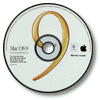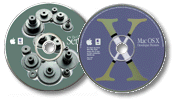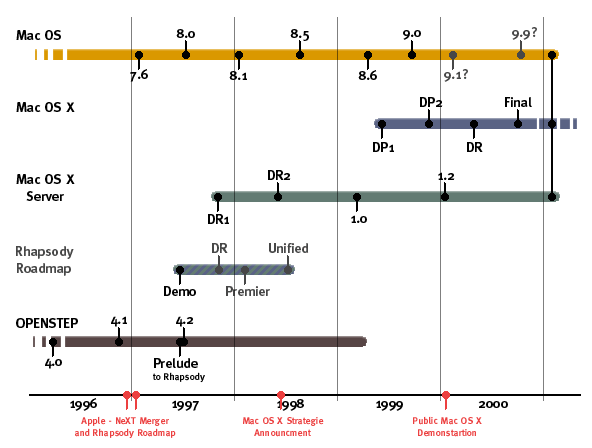

| 11. Jan. 2000. Tomi Engel |
|
||||||||||
|
|
|
|
|
||||||||

|
|||||||||||
On the 20.December 1996 the Rhapsody Brothers reunited and "saw the light". Apple Computers Inc. and NeXT Software Inc. announced that they will merge their technologies and that Steve Jobs will return, as a consultant, to the company he founded 20 years ago. One of the coolest "bands" in computer history was getting back together and at least some people were confident that there would be lots of really cool things happening in the near future.
It was pretty much like Jake and Elwood reuniting the Blues Brothers.
This publication wants to show why it was such a great event for the NeXT community and where Apples Mac OS X operating system has some of its roots. The focus will be mainly on technical aspects like the user interface and core system technologies.
The Plot
Back in 1996 Apple was in deep trouble since hardware sales were poor and the unsellable inventory was increasing day by day. The problem was related to clone manufacturers, who competed with Apple in an already small market, and Apples confusing and not very outstanding product line. The Mac OS started to show its age and with the introduction of Windows 95 it became really hard to convince people of the benefits that the Mac platform would offer.
Many years and even more dollars have been invested in a modern replacement, code named Copeland, but it was still not ready for prime time when Apples faced the increasing financial problems. The company was not only desperately shopping for a new operating system (even considering Windows NT at one point) but had to struggle with a historically low stock price and the pending danger of a hostile takeover from some of the big competitors.
NeXT had no easy times as well. The development of the OPENSTEP operating system was almost halted because trying to keep up with the rapidly changing Intel world was like fighting a losing battle without support from the hardware manufactures. NeXT drifted into the niche of a Windows NT development tool provider with focus on enterprise computing and dynamic web page generation. WebObjects was the only product left, which had a real future.
NeXT and Apple luckily realized that they were in the unique position to finally proof that sometimes: "1+1=3"

![]()

![]()

Both companies had important and mature technologies which the other was missing and a combination would make an incredibly great system. Besides that Apple had its own, still well respected, hardware platform and a world wide resale channel whereas NeXT had a streamlined, efficient organization, a good reputation in the IT departments of large corporations and they had ... well ... Steve Jobs.
Rhapsody
A new operating system strategy was badly needed and so a new road map had to be drawn over the holidays which could be presented to the press and Apples user and developer community at MacWorld, which was held in January 1997.
The new offspring was initially code named Rhapsody and somehow the name did fit like a glove. The system had the potential of becoming "an epic poem" which brings an excellent OS to elegant and powerful hardware.
rhap-so-dy \'rap-sed-e\
[L rhapsodia, fr. Gk rhapso idia recitation of selections from epic poetry, rhapsody, fr. rhaptein to sew, stitch together + aidein to sing; akin to OHG worf scythe handle, Gk rhepein to bend, incline - more at ODE]
(1542)
1: a portion of an epic poem adapted for recitation
2 archaic: a miscellaneous collection
3: a highly emotional literary work
4: a musical composition of irregular form having an improvisatory character
To us it was obvious right from the start, that it should be considered "Mac OS 10.0" but it was not until WWDC '98 that the final Mac OS X (where "X" should be pronounced as the number "10") strategy went public. From that day the name Rhapsody was only used to refer to a product strategy which was never implemented.
Before we go into the technical details of the Mac OS X merger we want you to understand the evolution, strategy shifts and release "delays" of Mac OS X. So we will first try to bring all projects in their historical context.
The Big Picture
After the merger the traditional Mac OS followed a very simple release pattern: major releases once a year, plus minor updates half a year later. This was part of the NeXT influence in the software development department which was now headed by Avie Tevanian. The focus shifted to fixed release dates instead of fixed feature sets.
The release dates have been mainly driven by the need to support new hardware which in most cases required updated drivers or support for special features. Mac OS 8.0 was am exception because bumping the version number was necessary for Apple in order to get rid off the clone hardware manufactures. They would need a new license if they wanted to keep up with Apple ... and Apple (read "Steve Jobs") would not grant them such a license for a similar bargain like they did under the old agreement. This basically killed the market of Apple clones.
Given the complexity of merging two operating systems it was obvious that it would take at least two major revisions before a convergence could be reached. Development on Mac OS 8 started before the merger, so it would take a Mac OS 9 to prepare the transition to a radically different system.

It was not only the naming confusion which made OPENSTEP look sad in 1996. The OpenStep alliance with Sun never really took off because Java found more hype and momentum inside Sun. This made NeXT the only company which supported the public specification and implemented it in a successor of its NeXTSTEP operating system which was now called OPENSTEP.
The technology was ahead of its time and had "cross platform" written all over it. OpenStep APIs have been available one three operating systems (Mach OS, Solaris and Windows NT) and NeXTs OPENSTEP was able to run on 4 hardware platforms (M68k, Intel, Sparc, PA-Risc).
Under the extreme time-to-market pressure it was not very surprising that Rhapsody, which was the codename of the first Apple-NeXT OS project, was basically an upgraded OPENSTEP release which added PowerPC hardware to its plate, included Mac OS compatibility via a closed extension (referred to as the "Blue Box") and was updated to look "Mac-ish". The tight roadmap called for a developer release followed by a premier and then unified release ... all within 18 month after the MacWorld '97 announcement.
At that time Apple was still in financial trouble and developers migrated away from the Mac platform so the promise of cross platform APIs (NeXTs OpenStep technology) was a key aspect in the initial strategy, since it kept developing Mac software attractive. Apple was struggling for survival and so it did not really matter too much that the given time frame was extremely optimistic.
The "rapid deployment team" at Apple had a lot of training in porting OPENSTEP (remember ... they already supported 4 CPUs) and managed to port OPENSTEP to the PowerPC within 3 month and to demo early builds of Rhapsody at WWDC '97 . This gave the developers confidence that Apple is no just making promises but actually delivering promises. A beta OPENSTEP 4.2 / Intel was distributed as the "Prelude to Rhapsody" to all developers so that they could testdrive the new OpenStep APIs.
The NeXT-inside-Apple still had to finish OPENSTEP 4.2, which they did after the Rhapsody demos succeeded in bringing back some of the lost confidence from the developer community. Apple continued selling OPENSTEP as a WebObjects development platform until Mac OS X Server 1.0 became available, but they never made a big deal out of it because the public focus should never be withdrawn from the traditional Mac OS and the Apple platform.
Nevertheless, Rhapsody was bound to fail in its current form because non of the big players (Adobe, Microsoft, Quark, ...) have been interested in rewriting their applications for the new "yellow" object oriented APIs nor did they feel very satisfied with being locked into a "blue box" and not getting any reward from the powerful new system core.
Behind the scenes this must have been clear quite early and while Apple started to look solid to the outside again it was still shaking and struggling badly behind the scenes. This was the time when Steve Jobs finally took over at Apple again and became the (permanent) iCEO. He refocused Apple on the Mac OS (releasing 8.0) and on producing excellent hardware (iMac, PowerBook G3, iBook, AirPort, PowerMac G4, ...).
Apple became stronger, more confident and more popular again. The stock was rising and Apple was back in business leading the industry again ... the Apple brand was stronger then ever and the company was selling hardware like crazy which in turn attrcted more developers to the platform.
Cross platform was dead and so was the Rhapsody strategy.
When Rhapsody DR1 shipped in late 1997 Apple already knew that they needed a different roadmap ... a different product. Instead of the dual OS strategy they needed a single OS strategy with a smooth transition for users and developers. Apple still needed a system that would scale for at least the next decade, so the importance of the Rhapsody technologies remained unchanged. But the upcoming OS should not distract for the shipping products and it should only make the Apple platform look great and not somebody else's hardware.
Carbon was the missing link and Mac OS X the main topic at WWDC '98. With Carbon Apple added a technology that allowed a smooth transition for the entire Apple community. With Mac OS X Apple made it clear that they are focusing on their own platform and that they will not spend time or money in supporting Intel or any other CPU in the near future. This was a shock for the NeXT community.
The majority of the WebObjects world was happy with OPENSTEP/NT as their development system and the various supported deployment platforms. There was no big demand for a 100% Apple solution, even when it looked strange that one of the most successful (in terms of revenue) Apple software products (read "WebObjects") did not even run on Apple hardware.
Mac OS X Server 1.0, which was the now retargeted Rhapsody "Primer" project, was searching for a reason to exist and had to wait for two other Apple technologies before it made its public debut in early 1999. With the addition of the NetBoot technology and the new QuickTime streaming server Apple finally found a niche where it could place the mature server system without hurting the Mac OS.
Besides the missing Intel support and the mentioned additions not much had changed compared to early Rhapsody developer releases. The team was internally focusing on the next big thing: the real Mac OS X.
Mac OS X is conceptually almost identical with OS X Server but the code base represents a complete rewrite (Core OS, IOKit, Core Foundation, Quartz, Java2, ... ). The "rapid deployment team" must have felt really good when they managed to get a reasonably stable release out of the door just in time to produce the Mac OS X Developer Preview 1 which was given to all attendees of WWDC '99.
The second preview release was a lot more stable and included some new features (support for Carbon, booting from HFS+, etc... ) but the system still looked ugly which suggested that the interface is still being worked on. Those who did their own math and followed some of the recent changes at Apple (new Apple Store, QuickTime Player, the Mac OS 9 login panel and the Quartz shadow/transparency features) knew that the final look must be something radically different.
At MacWorld 2000 Apple went public with the full Mac OS X strategy. They did not only present the roadmap to a unified OS strategy but they also demoed the Aqua user interface and blew everybody away. While most have been overwhelmed by the beauty of the interface it might have been the NeXT people who were even more surprised: many of the good NeXT GUI concepts, which seemed to be lost forever, were not only back, but have been radically improved as well.
Before we get started ...
Still not all aspects of Mac OS X are known in detail. So it might be that we get some aspects slightly wrong, but we try not to slip too often.
This publication uses a 3 column layout which shows Mac OS, OPENSTEP and Mac OS X solutions right next to each other. Therefore a screen width of at least 640 pixels is useful and more is even better. Whenever possible the headlines of the single "features" will take you to places where you can read in more detail about the described technology.
The two main section which you can enter now are:
- User Interfaces ... see how it feels
- Technologies ... read how it works
If you are interested in more Apple history then you should go to MacKiDo or the Low End Mac site which both have a complete list of all major events. Some insiged into NeXTs history is on the web as well and for those who would like to browse Mac OS X and Rhapsody announcements we strongly recommend the stepwise news index.
Our next secion will take you to the world of user interfaces ...



